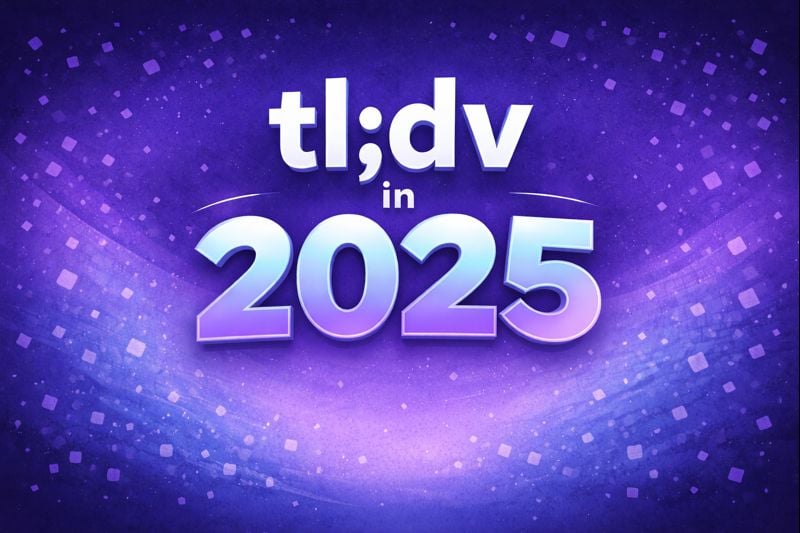Иногда может показаться, что отдел продаж и отдел продукции не работают в одной команде. Хотя все они могут быть друзьями и даже удачно пошутить вместе на рождественской вечеринке, скорее всего, при случае они будут перекидываться фразами.
Хотя это звучит... ужасно, на самом деле это вполне нормально. Отделу продаж часто кажется, что они предлагают единорога, в то время как команда разработчиков продукта, по сути, создала лошадь. Это не недостаток, далеко не недостаток, но это не совсем то мифическое существо, которое продавалось клиентам.
@tldv.io Получите свой пакет продаж 💪🏼 #productmanagement #sales #tech #startup #corporate #meeting #transcription #aitools
♬ оригинальный звук - tldv.io - ИИ-помощник для записи встреч
Именно здесь может помочь использование видеозаписей разговоров. Они являются источником беспристрастных и непредвзятых записей, фиксирующих голос клиента (а также то, что люди говорили им). Они позволяют передавать неискаженную обратную связь прямо из уст клиента как в отдел продаж, так и в Product. Используя эти видеофрагменты, Product может увидеть, о чем просят клиенты (а также что предлагает отдел продаж), отдел продаж может понять, почему Product не может предложить все, что обещал, и сформировать более реалистичные ожидания.
Другой способ - использовать классический сценарий романтических фильмов, где лучшие друзья тайно любят друг друга, но постоянно недопонимают. Запись разговора - это незлобивый приятель, который, наконец, запирает их в одной комнате, чтобы разобраться в своих чувствах (и заблуждениях), что приводит к душевному взаимопониманию. О!
Видеозаписи - это энциклопедия проверки реальности. Они разоблачают желаемое за действительное, давая четкое представление о том, чего действительно хочет заказчик, и, что не менее важно, что может быть реализовано. Для команды разработчиков продукта это все равно что получить бесплатный билет на живое выступление продавца - он видит, как именно преподносятся и воспринимаются его творения. Для отдела продаж - это мастер-класс по функциональности продукта, позволяющий понять, что возможно, а что - фантазия.
Конечная цель? Просвещенная команда разработчиков, которая лучше понимает ожидания клиентов, и более информированный отдел продаж, который знает, где провести границу между амбициозными продажами и завышенными обещаниями. Это новое понимание поможет обеим командам гармонично работать над достижением общей цели, в результате чего продукт будет соответствовать предложению продавца, а предложение - точному представлению продукта.
Почему существует разрыв
Сотрудники отделов продаж в основном руководствуются целями, ориентированными на получение прибыли, а именно: зарабатыванием денег и выполнением квот. Стремление к достижению поставленных целей и получению комиссионных иногда приводит к завышению обещаний относительно характеристик продукта. Считайте это результатом структуры мотивации, в которой индивидуальная выгода важнее комплексной точности. В этой гонке к финишу отделы продаж можно рассматривать как зайца, который бежит вперед, оставляя за собой черепаху, которая не успевает за продуктом.
Все это осложняется проблемой, известной как информационная асимметрия. Сотрудники отдела продаж, находясь в непосредственном контакте с клиентами, часто обладают важной информацией о потребностях и предпочтениях покупателей. В результате у них может сформироваться убеждение, что они понимают рынок лучше, чем их коллеги, что создает напряженность при согласовании характеристик продукта с ожиданиями рынка.

Дополнительное топливо в огонь подливает ощущение фаворитизма. Отделы продаж часто оказываются в центре внимания, поскольку их деятельность приносит доход, что может вызвать недовольство других подразделений, которые считают, что их вклад недооценен. Создается впечатление, что продажи - это главные актеры, которым аплодируют, а продуктовые команды чувствуют себя как закулисная команда, чья важная работа остается незамеченной.
Несоответствие возникает, когда нарушается коммуникация. Если отделы продаж не могут эффективно донести до клиентов требования или ограничения продукта, неизбежно возникают недопонимания и конфликты. Отсутствие гармонии может ухудшить отношения и повысить продуктивность, подобно тому как оркестр играет не в такт. Это касается не только отдела продаж, но и маркетинга.
Наконец, стереотипы и предубеждения также могут стать камнем преткновения. Сотрудники отдела продаж могут восприниматься как слишком агрессивные, а сотрудники отдела производства - как слишком жесткие или медлительные. Такие укоренившиеся представления могут привести к дальнейшим разногласиям и непониманию.
Признание этих проблем - первый шаг на пути к устранению разрыва между отделами продаж и продуктами. Следующий шаг - создание среды, способствующей пониманию, сопереживанию и эффективному общению.
Психология совместной работы
Существует множество теорий, объясняющих причины конфликтов между отделами, но не меньше исследований посвящено тому, как способствовать развитию сотрудничества. Это сложный танец между признанием индивидуальных перспектив и формированием общего видения.
Начнем с теории группового развития Брюса Такмана. По мнению Такмана, группы проходят четыре стадии развития - формирование, штурм, нормализация и исполнение. Формирование - это вежливая фаза медового месяца, когда группа только начинает объединяться. Штурм включает в себя неизбежные разногласия и борьбу за власть, когда отдельные члены начинают высказывать свои идеи. Нормирование происходит, когда пыль оседает, и группа устанавливает нормы и роли, способствующие сплоченности. Наконец, на стадии исполнения группа функционирует как единое целое, двигаясь к достижению общих целей. Осознание этих стадий поможет управлять динамикой коллектива и способствовать улучшению коммуникации.
Еще одним психологическим фактором, влияющим на совместную работу, является практика активного слушания и эмпатии. В современном быстро меняющемся мире умение выслушать точку зрения собеседника становится как никогда ценным. Активное слушание предполагает полное сосредоточение внимания на говорящем, понимание его сообщения и предоставление содержательной обратной связи. В сочетании с эмпатией - способностью понимать и разделять чувства других людей - это может способствовать улучшению коммуникации и взаимопонимания между членами коллектива. В равной степени над этим должны работать и сотрудники отдела продаж, если они еще этого не делают!
Использование методов совместного решения проблем также может сыграть решающую роль в преодолении разногласий между подразделениями. Эти методы предполагают вовлечение нескольких заинтересованных сторон, открытый диалог и поиск взаимовыгодных решений. В определенном смысле это превращает процесс решения проблем в демократическую деятельность, позволяющую услышать каждый голос и учесть все точки зрения.
Не менее важным является развитие эмоционального интеллекта в команде. Эта концепция, выдвинутая на первый план такими исследователями, как Майер, Саловей и Карузо, предполагает распознавание и управление эмоциями в себе и других. Эмоциональный интеллект включает в себя самосознание, саморегуляцию, эмпатию и навыки эффективного общения. При высоком уровне эмоционального интеллекта команды могут лучше ориентироваться в межличностных отношениях, что снижает вероятность возникновения конфликтов.
Наконец, ориентация на построение взаимоотношений может способствовать формированию позитивной организационной культуры, поощряя сотрудничество и общение. Этот процесс включает в себя формирование доверия, взаимное уважение и поощрение командной работы. Когда коллектив работает в атмосфере, где ценят его вклад и прислушиваются к его мнению, легче достичь общих целей и добиться синергетического эффекта.
Таким образом, несмотря на наличие множества причин для конфликтов, существует также обширный набор инструментов для достижения гармонии. Немного понимания, активного слушания, совместного решения проблем, эмоционального интеллекта и выстраивания отношений - и мы можем превратить поле боя отдела в мозговой центр для совместной работы.
Использование возможностей записи видеозвонков
Записи видеозвонков - это сокровищница нефильтрованных отзывов клиентов, и, как скажет вам любой психолог, первый шаг к пониманию - это умение слушать. Когда сотрудники отдела продаж и отдела продукта вместе прослушивают эти записи, они не просто слышат жалобы или похвалы клиентов. Они проникают в сознание клиента, видят продукт с его точки зрения.
А когда все начинают понимать точку зрения клиента, работать над достижением общей цели становится гораздо проще.
Еще один психологический "самородок" представлен в виде эффекта "простого воздействия" (Mere Exposure Effect). Он заключается в том, что люди склонны отдавать предпочтение тем или иным вещам только потому, что они им знакомы. Регулярно прослушивая записи разговоров, команда разработчиков может лучше узнать язык, потребности и предпочтения клиентов. Такое знакомство может привести к сопереживанию и пониманию, способствуя установлению более тесной связи между командой разработчиков и конечным пользователем.
Но сила записей разговоров заключается не только в том, что они способствуют взаимопониманию. Она также направлена на улучшение коммуникации. Все мы в детстве играли в игру "Телефон", где сообщение уморительно искажается при передаче от одного человека к другому. В бизнесе это не так смешно. Записи разговоров позволяют убедиться в том, что все слышат одно и то же сообщение, что уменьшает количество недоразумений и позволяет команде разработчиков получать информацию об отзывах клиентов из первых рук.
Не стоит забывать и о роли записей разговоров в совместном решении проблем. Прослушивая записи разговоров вместе, команды могут проводить "мозговой штурм" решений на основе обратной связи с клиентами в режиме реального времени. Это похоже на то, как если бы клиент присутствовал на мозговом штурме и направлял процесс принятия решений.
Кроме того, существует вопрос доверия. Ничто так не укрепляет доверие, как прозрачность, а записи разговоров дают такую возможность в полной мере. Имея доступ к записям звонков, команда разработчиков может убедиться, что отдел продаж не дает ложных обещаний и не устанавливает нереалистичных ожиданий. Это похоже на упражнение "падение доверия", но без риска вывиха лодыжки.
Запись разговоров для улучшения совместной работы
Теперь, когда мы убедились, что запись видеозвонков может быть очень полезна для сглаживания любых проблем в общении между менеджментом продаж и менеджментом продукта. Как же ее применить?
Шаг 1: Выберите подходящий инструмент *подсказка* tl;dv - это круто
Путь к эффективному межведомственному общению начинается с выбора правильного инструмента. tl;dv оснащен функциями, основанными на искусственном интеллекте и предназначенными для оптимизации общения. Благодаря расширенным возможностям фильтрации tl;dv позволяет командам дойти до самой сути взаимодействия с клиентами, минуя ненужное и сосредоточившись на том, что действительно важно. Поиск по ключевым словам, чтение автоматически сгенерированных стенограмм (с указанием того, кто что сказал) и резюме, созданных искусственным интеллектом, для быстрого поиска информации.
Шаг 2: Меры по обеспечению конфиденциальности
Прежде чем нажать кнопку записи, необходимо создать надежную систему защиты конфиденциальности. Обязательным условием является информирование участников о записи, получение их согласия и соблюдение всех необходимых норм. Тем самым вы создаете атмосферу доверия и прозрачности, которая выходит за рамки простого соблюдения правовых норм.
Шаг 3: Обучение персонала
Далее следует этап тренировок. К счастью, с tl;dv это не такой уж крутой подъем. Интуитивно понятный дизайн и простые для восприятия функции обеспечивают короткую кривую обучения, позволяя вашим командам быстро освоиться и начать использовать программное обеспечение. Вы можете буквально нажать на кнопку или получить автоматическую настройку. Требуется совсем немного обучения!
Шаг 4: Использование программного обеспечения
Теперь, когда ваши сотрудники хорошо знакомы с tl;dv , пришло время интегрировать его в рабочий процесс. Записи звонков можно использовать в самых разных ситуациях - от официальных совещаний команды до мозговых штурмов и неформальных встреч. Благодаря потрясающим функциям tl;dvвы сможете быстро получить доступ к ключевым разговорам, сэкономив время и силы. И еще один бонус? Это также отличный инструмент интеграции с CRM, работающий напрямую с SalesForce и другими внутренними CRM.

Шаг 5: Стать свидетелем преобразований
Когда регулярное использование записей разговоров станет регулярным, плоды ваших усилий начнут проявляться. Благодаря общему пониманию, которое обеспечивает tl;dv , пропасть между отделами продаж и продуктами начнет сокращаться. Улучшение коммуникации, расширение сотрудничества и достижение общих целей перестанут быть несбыточной мечтой, а станут повседневной реальностью. Более того, информация, полученная в ходе взаимодействия с клиентами, некоторые из которых могут иметь юмористический оттенок, привнесет в рабочие будни долю легкости.
Давайте просто жить дружно!
По мере того как мы заглядываем в хрустальный шар совместной работы, картина становится все более четкой. Будущее обещает стать очень перспективным для дальнейшего укрепления единства команды продавцов и производителей, и технология записи разговоров, как и tl;dv, играет центральную роль в этом дальновидном сценарии. Представьте себе передовые функции, которые не только улавливают каждый вздох или смешок, но и анализируют тон, эмоции и, возможно, даже предсказывают следующую большую тенденцию в вашей отрасли. Кто знает? Случайный разговор вашей команды о любимых пончиках может привести к революционной идее продукта, которая захватит весь мир!
Но прежде чем мы увлечемся инновациями, вдохновленными пончиками, давайте вернемся к сегодняшнему дню. Использование возможностей записей разговоров сегодня может способствовать улучшению коммуникации, расширению сотрудничества и внедрению инноваций, ориентированных на клиента. Преодоление разрыва между отделами продаж и продуктами - это не создание единорогов или превращение лошадей в мифических существ. Речь идет о том, чтобы понять и предоставить клиентам то, что им действительно нужно, на основе взаимного уважения и сотрудничества между командами.
Помните, что почти в каждом разговоре есть золотая жила информации, которая только и ждет, чтобы ее обнаружили. Так почему бы не вооружить свои команды эквивалентом металлоискателя для разговоров - tl;dv! Пусть отныне все ваши межведомственные стычки будут такими же значимыми, как споры о последнем куске пиццы на офисной кухне. А когда это произойдет, не забудьте нажать на запись. Ведь, как мы убедились, даже самые обычные разговоры могут привести к следующей большой идее или, по крайней мере, обеспечить столь необходимое офису развлечение!





